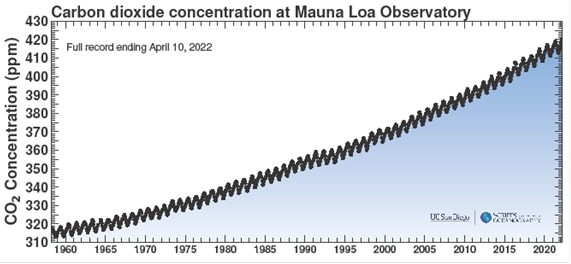Notes for presentation to the SA Sustainable Agriculture Network
12 April 2022.
KEELING CURVE:

Maccy Biochar is a volunteer community group based in Macclesfield, SA established in 2019 and now comprising about 50 members.
Our objective is to help fight climate change by increasing carbon drawdown by making carbon negative biochar and using the biochar as a soil amendment.
As at end of season last year we had produced about 40,000 litres of biochar and removed about 20 tonnes of CO2 from the atmosphere.
We take waste biomass (mainly tree litter) from households and businesses and convert it to biochar; thereby helping to reduce green waste and fire hazards from ‘burn heaps’ and accumulated litter.
We do NOT collect woody debris from natural bushland or any area where wildlife habitat and/or biodiversity is being protected or fostered by bush-care groups, land-care groups, landowners, etc.).
We use simple but clean technology that makes good quality biochar without undue smoke or particulate emissions.
We observe strict OHS&E safety and quality protocols and maintain an Operations Manual to guide members at every stage of the process.
We send representative samples of our biochar to an analytical laboratory for regular testing of moisture, dry Bulk Density, ash and volatile matter, pH, EC, TOC, TC, Nutrients (eg Ca, Mg, K, Na, S, P, Mn, Fe,) Heavy Metals (eg Zn, Cu, Co, Se, Cd, Pb, As, Cr, Ni, Hg, Ag) and PAH’s.
We try to educate landowners on the advantages and uses of biochar to assist with water & nutrient retention, improved soil microbial health, acidity reduction, reduced need for fertilizer and therefore reduced nitrous oxide emissions.
We also try to explain to landowners how and why these advantages arise:
Eg Water holding capacity: This arises from the highly porous nature of biochar; its nevertheless solid structure making it resistant to breakdown; its ability to hold up to 5 times its own weight of water (so if BD of biochar is say 200gm/L versus 1000gm/L for water; 10L of biochar will hold about 10L of water). Show jar of water containing 2 lumps of biochar – 1 saturated with water at the bottom of the jar – the other floating.
Eg. Nutrient retention: Most plant nutrients when in solution exist as positive ions (so-called cations because they are attracted to the cathode or negative terminal of a battery). These are attracted to negative charged surfaces within the biochar pores. This feature is called its cation exchange capacity. Amazingly some biochar surfaces can also be positively charged giving rise to an anion exchange capacity thereby attracting negative ions (so-called anions and notable among these are phosphorus, and the oxides of nitrogen: the nitrites and nitrates).
Eg. Improved soil microbial health: Soil bacteria and fungi are attracted to the biochar pores by the presence of moisture and nutrients and therefore benefit from the biochar; this translates into improved plant health arising from the proximity of their root fibres to the soil bacteria and fungi they need to interact with to survive and grow.
All life forms are opportunistic. But to exist they need 3 things: food, water and shelter! When it comes to underground life biochar provides all 3 ingredients in one handy package. So by sequestering biochar in the soil we are helping soil life forms to do what comes naturally without undue interference; without artificial stimulation (eg inorganic fertilizers); and without the destruction of other life forms (eg pesticides/herbicides).
But as biochar is not , by itself, a fertilizer, we recommend using enhanced biochar (already enhanced with nutrients) for re-vegetation projects to optimize early growth and success rate of new plantings. And we want to encourage farmers and land managers who are looking towards regenerative farming methods to understand biochar as another way to help the natural processes within the soil do what they were evolved to do. Biochar and Sustainable Agriculture seem to me to be natural partners.
We are ready to assist other community groups set up and operate biochar groups throughout the State.
By establishing a network of community biochar groups around the State we will increase the supply of carbon-negative bulk biochar available to farmers and allow more farmers to start using biochar to improve their soil health and farm performance while possibly earning carbon credits.
The advantages of using a community group approach to making carbon negative biochar versus the large commercial scale approach are:
Feedstock is local, self-renewing & free.
Labour costs are zero.
Capital costs are negligible.
Production costs are very low.
Delivery of finished product is local.
Amount of product needed before it is carbon-negative is very small (about 1 bulk bag (1000L)).
Of course,if a large scale commercial biochar plant can be proven to be carbon negative within a reasonable time-frame then do it! But until then I think this is the best we’ve got.
SO if you agree with our objectives in relation to carbon negative biochar can you help us promote the community group approach in your region?
By doing this we will:
Show that people know and care about carbon emissions;
Do something to reduce emissions while improving local soils;
Help farmers to understand what biochar can and cannot do for them.
We can provide basic training on biochar fundamentals, demonstrate the production process, and assist with getting new groups operational.
VISION FOR AN SA BIOCHAR NETWORK:
All country towns in SA with a population over a certain number (say 500) to form a biochar group comprising 5 or more people to make carbon negative biochar during non-fire ban days (eg May to November) with flame-capped kilns or similar (to ensure clean emissions);
AND sequester the biochar as part of local soil improvement projects;
AND aggregate their carbon offsets so as to qualify for carbon credits under a certified accreditation system.
Leave a Reply